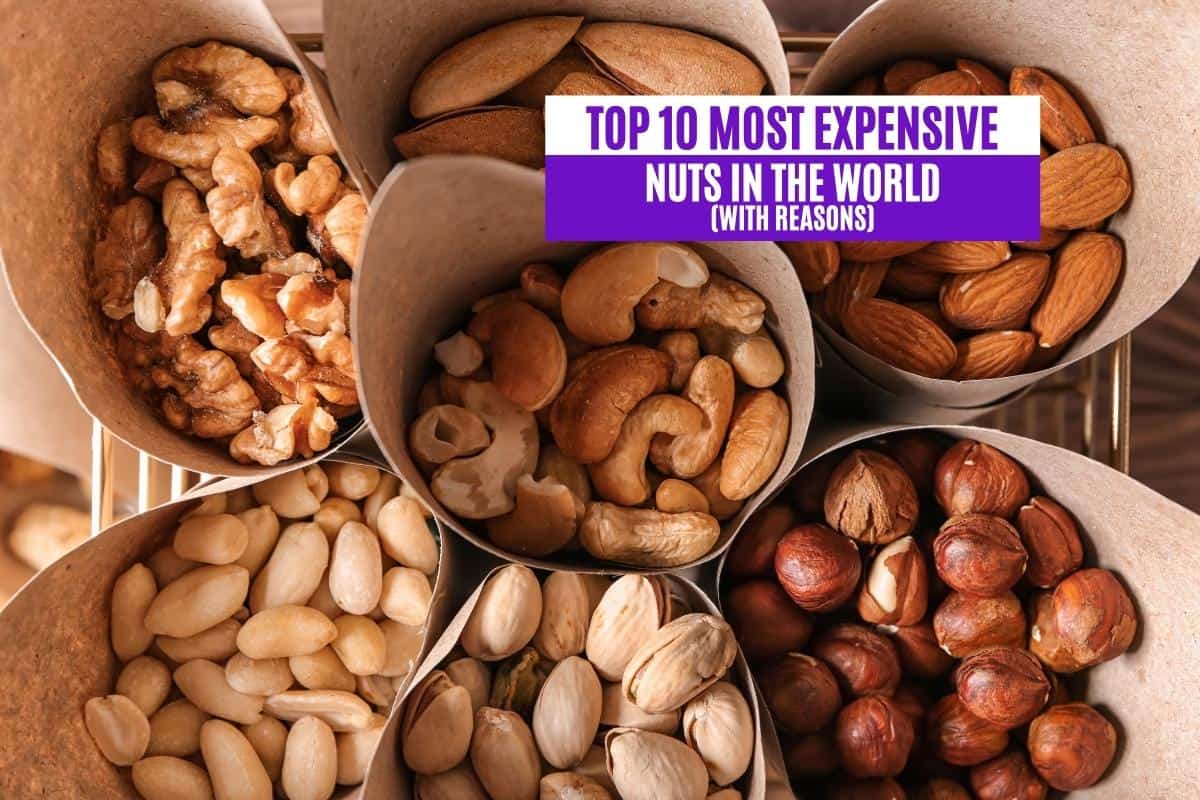Nuts are popular snacks due to their high nutritional content and delicious flavors, but they’re some of the most expensive ingredients on the planet. But some nuts are far pricier than others.
The most expensive nut in the world is the Mediterranean pine nut, also called a pignolia. These nuts cost about $45 per pound. They grow in rugged environments and feature a silky-smooth texture and rich flavor profile. Pili nuts (grown in the Philippines) are almost just as pricey.
Thie guide will discuss the reasons why nuts are expensive. We’ll also rank the most expensive nuts in the world, ensuring that you choose a luxury-quality nut that suits your palate and your budget.
What Factors Make Nuts So Expensive?
If you enjoy snacking on mixed nuts, you’ve likely noticed how expensive nuts are. After all, a bag of potato chips might cost about $4 for 8 ounces, but a similarly-sized container of mixed nuts typically costs $6 or more!
There are quite a few things that make nuts more expensive than other snacks. Some of the most significant factors influencing nut prices include:
- Growing challenges
- Time constraints
- Desirable health benefits
- Transportation costs
One of the best ways to understand why some nuts are more expensive than others is to consider these factors. So, without further ado, let’s explore the top reasons why nuts are costly.
Growing Challenges
While you might be able to grow peanuts in a simple pot, other types of nuts require complex growing conditions and environments. For example, pine nuts come from full-grown pinyon pine trees that thrive in semiarid or Mediterranean climates.
Humid and cold climates can kill these trees, resulting in a dramatic drop in pine nut supply. Additionally, some nut-bearing plants take several years to start producing nuts, which is another considerable growing challenge.
Time Constraints
Some nut-bearing plants and trees take nearly half a decade to produce harvestable nuts. For example, macadamia nut trees don’t start making nuts until they’re five years old. At this point, they might only bear a handful of edible nuts.
It takes more than a decade for these trees to reach full production, so farmers looking to grow nut-bearing trees have to wait a long time to see a profit from their crops. These time constraints make some nuts scarce, as many producers aren’t willing to invest the long-term time and effort to grow them.
Those who decide to grow nut-bearing trees typically mark up the cost of their products to account for the labor and time required to produce nuts. Additionally, nuts of all types are consistently in high demand, partially due to the various health benefits they provide.
Desirable Health Benefits
Unlike many other typical snacks (like chips, candy, and fried foods), snacks are wholesome and healthy. Though the nutrient content of nuts varies depending on the type, most nuts are rich in unsaturated fats, fiber, and minerals. These qualities make nuts a heart-healthy and gut-friendly alternative to other snacks.
You can also add nuts to other ingredients to create elevated meals. For example, a handful of crushed pistachios makes a perfect coating for a tuna filet, and peanuts are a common addition to Thai cuisine.
Transportation Costs
Many of the world’s most expensive nuts are grown in remote regions or faraway countries. That’s because some nut species require specific soil and light conditions to thrive. Consequently, many types of nuts incur high transportation costs.
When you add a long growing process and high demand to these shipping costs, prices skyrocket. For that reason, many of the most high-maintenance nuts (those that only grow in certain places around the world) command the steepest prices.
Most Expensive Nut: Summary List
- Mediterranean Pine Nuts
- Pili Nuts
- Pistachios
- Baru Nuts
- Macadamia Nuts
- Pine Nuts
- Pecans
- Brazil Nuts
- Walnuts
- Hazelnuts
10. Hazelnuts
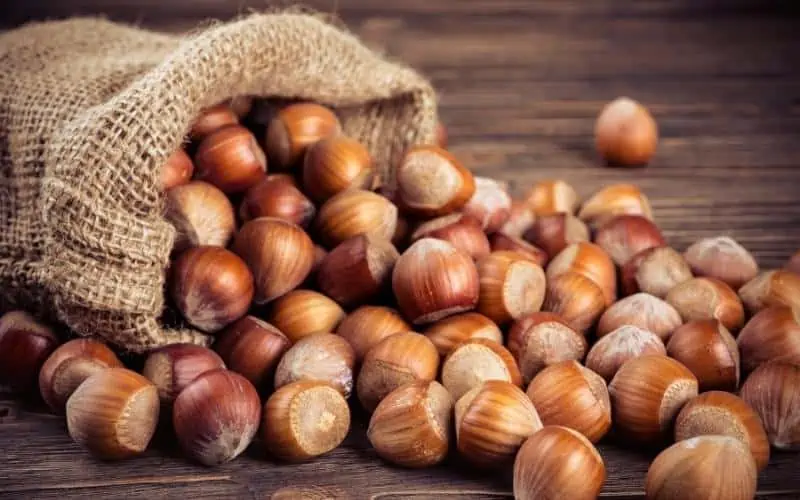
As you might suspect, hazelnuts come from hazel trees. They’re similar to acorns in shape and appearance, and they have a distinctly earthy flavor. Roasted hazelnuts are a popular treat, especially during the winter season.
But while these nuts are an excellent holiday treat, they’re also somewhat pricey. You can expect to spend upwards of $7 per pound on shelled hazelnuts. However, if you’re willing to crack open the shells yourself, you could save a little on these wholesome snacks.
Why It’s Expensive
It takes a hazel tree approximately four years to start producing nuts. But this tree doesn’t kick things into high gear until it’s about seven years old.
This longer growing period makes them pricier than fast-growing nuts and legumes. In addition, hazelnuts (also called filberts) are a popular holiday snack, so they experience high demand during specific times of the year. As a result, hazelnuts are often at their most expensive during the wintertime.
9. Walnuts
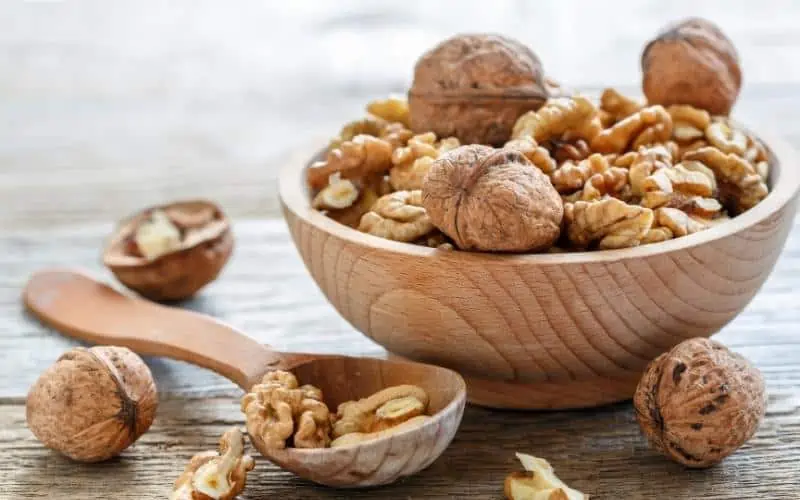
Walnuts are lobe-shaped nuts hidden inside round, gray-and-black shells. Their shape is often compared to that of the human brain, and for a good reason!
These nuts are full of nutrients, including omega-3 fatty acids and polyphenols. These compounds may help boost cognitive ability, making them a brain-friendly snack.
Fortunately, walnut trees grow somewhat quickly. But these trees still take about a decade to start producing nuts, which makes these nuts relatively pricey. Depending on the retailer, a pound of shelled walnuts might cost you between $15 and $19.
Why It’s Expensive
The time required to grow a walnut tree is one of the primary reasons walnuts are so expensive. However, walnuts are prized for their nutritional content and mild taste, so high demand also drives up their price.
8. Brazil Nuts
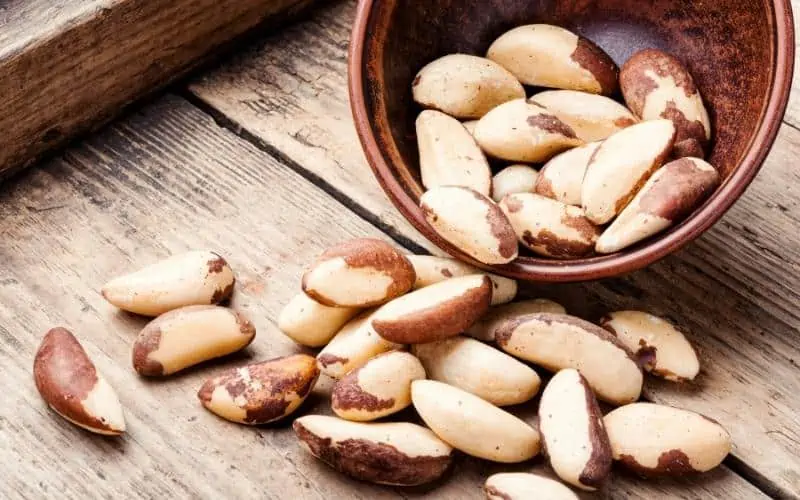
Brazil nuts are large, soft, and a fantastic snack. They’re among the few nuts that provide a decent amount of selenium, a compound known for improving cognitive function and boosting the immune system.
These nuts originate from the Amazon River basin. They come from massive trees that produce coconut-like pods, each one hiding several nuts. In fact, Brazil nut trees primarily grow in South America, limiting their supply and making them relatively expensive.
If you’re eager to enjoy the rich taste and unique health benefits of these nuts, you’ll likely spend at least $20 per pound.
Why It’s Expensive
Brazil nuts are only grown in South America, and the Brazil nut tree can take up to two decades to start producing nuts. This slow growth and specific growing environment make Brazil nuts some of the priciest nuts on the planet.
7. Pecans
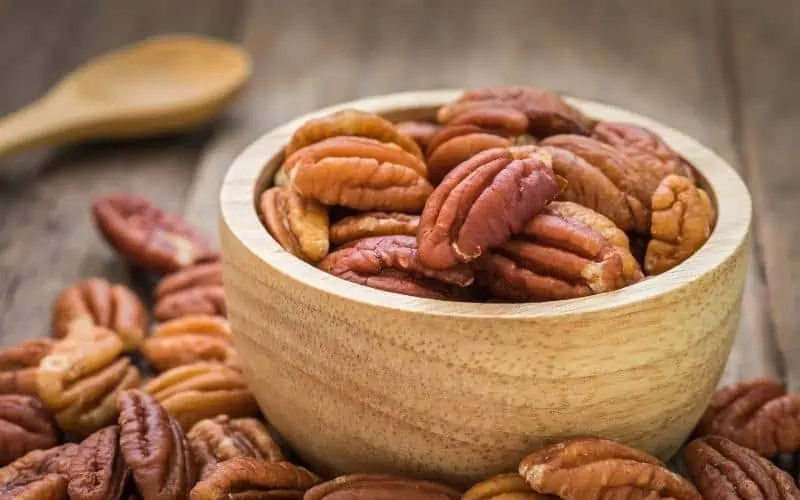
Organic raw pecans cost about $22 per pound, making them one of the most expensive nuts in the world. If you prefer your pecans roasted, you can expect to spend a little more (about $23 per pound).
These nuts are some of the sweetest and creamiest nuts, lending them well to desserts of all types. Pecans and ice cream go hand-in-hand, so be sure to pair some raw pecan halves with the most expensive ice creams!
These oblong nuts are also rich in wholesome nutrients like vitamin E, potassium, and zinc. Because they’re a healthy snack, pecans are always in demand.
Why It’s Expensive
Pecan trees can start producing nuts in as little as three years, making them a comparatively fast-growing nut-bearing plant. But pecans are some of the most popular nuts in the world due to their taste and vitamin content. So their price remains somewhat high.
6. Pine Nuts
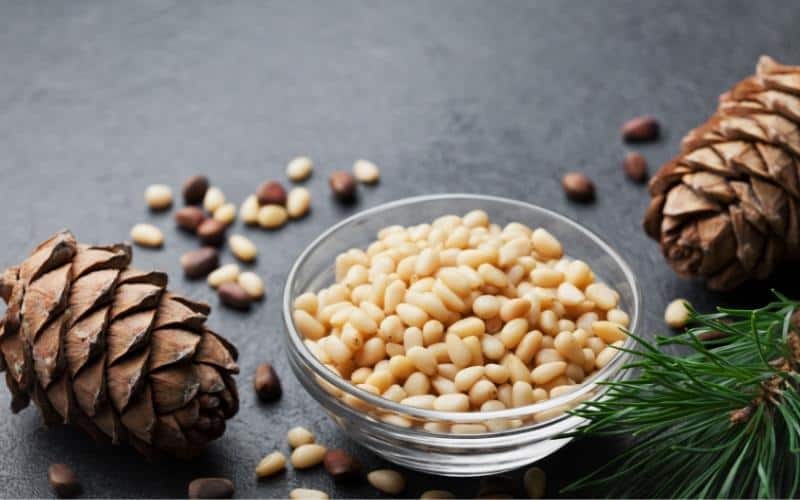
Though many people have allergies to pine nuts, those who can safely consume them are in for a treat. These nuts are soft and mild, and they’re also overflowing with nutrients.
When you eat a handful of pine nuts, you’re enjoying a boost of iron, zinc, and magnesium. Pine nuts are also rich in protein and antioxidants, making them far healthier than peanuts or macadamia nuts (both high in fats). They often cost about $22 per pound.
Why It’s Expensive
Pine nuts are expensive because they’re challenging to grow and extremely popular. Pine nuts are often used to create various foods, including cookies, cakes, pesto sauce, salads, pizzas, and ice cream.
The average pinyon pine tree takes about ten years to produce pine nuts, but the demand is always high. That said, the price of a pine nut often varies depending on where the nut was grown. But we’ll touch on that a little later.
5. Macadamia Nuts
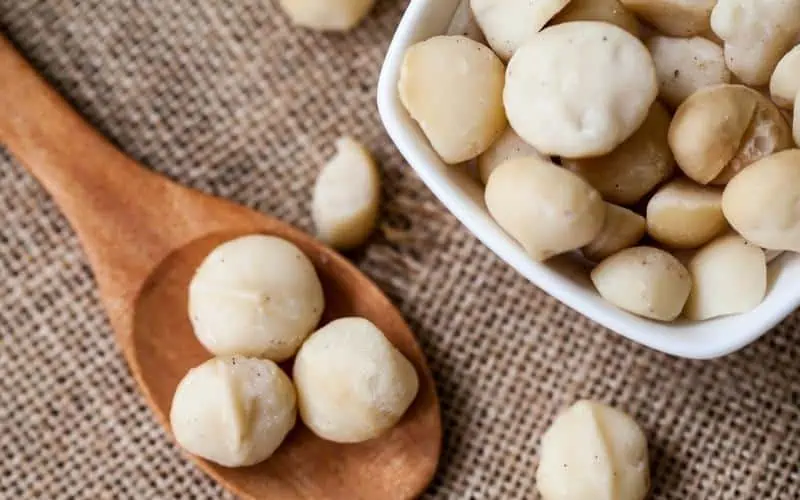
The large, pearl-like macadamia nut has a reputation for being the most expensive nut in the world. And, to be fair, it is far pricier than peanuts and almonds. That said, its $25-per-pound price tag pales in comparison to other types of nuts.
Macadamia nuts are popular for several reasons, including taste. They have a smooth, butter-like texture and flavor that pairs well with baked goods. Consequently, you’ll likely find them included in cookie recipes!
However, eating these nuts raw is just as pleasant, as they have a firm exterior but a slightly softer interior. This quality makes macadamia nuts somewhat easier on the teeth than hard nuts like almonds.
Why It’s Expensive
There are two reasons why macadamia nuts are more expensive than many other nuts. Firstly, macadamia trees can take a decade or longer to produce nuts.
This slow growth means that farmers won’t see profits from their trees for several years. As such, macadamia trees grow a time and resource debt until they can produce an abundance of nuts.
However, macadamia nuts are also exceptionally popular due to their health benefits and rich, buttery flavor. Because they’re in high demand and take ages to grow, supply always falls below market demand. This relationship results in higher prices.
4. Baru Nuts
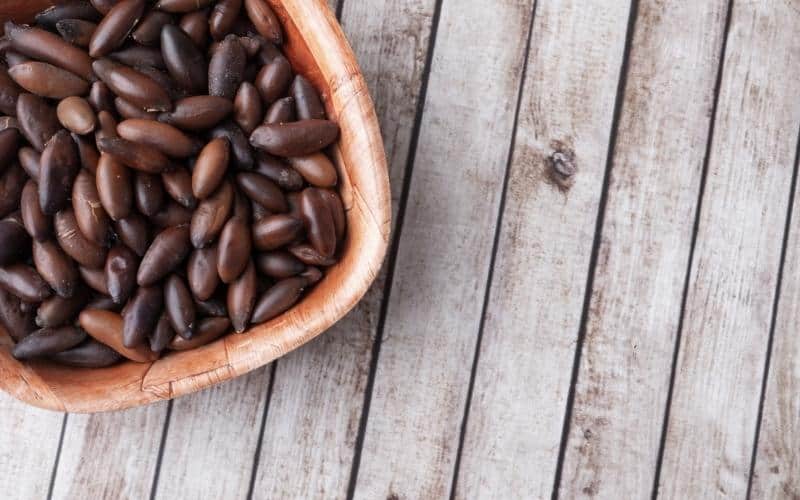
At first glance, Baru nuts might look like smooth coffee beans or chocolate-covered pine nuts. However, they have a rich flavor similar to cashews or peanuts.
Their dark brown exteriors hide a pale nut that’s one of the most nutrient-rich nuts in the world. Baru nuts are chock-full of gut-friendly dietary fiber, protein, calcium, and iron. As a result, they’re an excellent dietary addition for those who avoid meats and dairy.
Still, Baru nuts are only grown in specific regions of Brazil. They’re not the easiest nuts to find, and they can cost a pretty penny to ship. They’re also comparatively expensive, with an average cost of about $26 per pound.
Why It’s Expensive
If you’d like to try these rare nuts for yourself, you’ll need to anticipate a few price-raising factors. One of the most significant considerations is scarcity. While peanuts might flourish in most environments, Baru nuts only thrive in Brazilian savannah environments.
And because they hail from a specific region, shipping costs can raise this nut’s price tag. Still, the health benefits of this nut might make the elevated cost worth it.
3. Pistachios
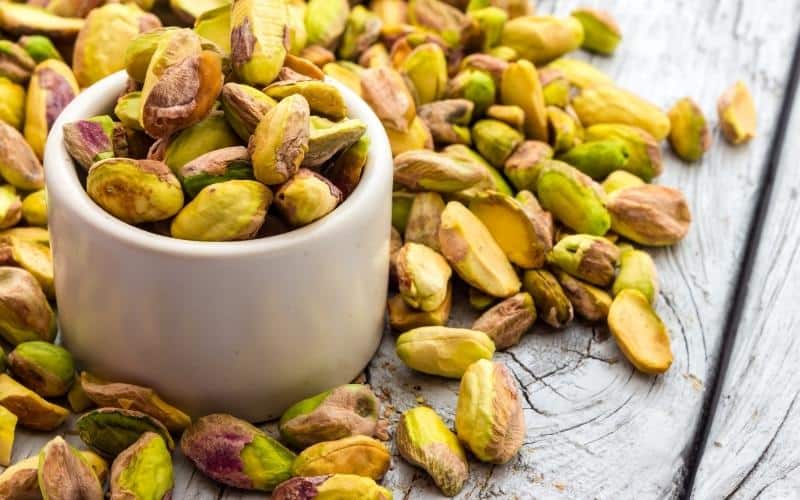
Pistachio nuts are rich green-and-purple seeds partially concealed by off-white hard shells. These nuts grow on pistachio trees, originating in semiarid areas throughout the Middle East and Asia. Today, you can find pistachio trees in California, New Mexico, and Arizona.
Like peanuts and almonds, pistachios are some of the most popular nuts in North American markets. Unlike other standard types of nuts, pistachios have a light, pine-like flavor that’s almost minty.
For this reason, pistachios are often added to sweets (like ice cream). However, desserts aren’t the only way to consume pistachio nuts. Many of the most expensive fish cuts (including tuna) pair well with pistachios, so you might want to incorporate some luxury ingredients together to create a high-quality dish.
Of course, you’ll need to be prepared to invest in you’re determined to enjoy the highest-quality pistachios. A one-pound bag typically costs $28 or more!
Why It’s Expensive
Pistachio trees are sensitive to extreme temperature changes and humid conditions. For that reason, they only flourish in semiarid environments, limiting the areas where people can grow them.
Additionally, a pistachio tree can take up to eight years to produce nuts and about two decades to hit its production stride. Therefore, cultivating these nut-bearing plants requires plenty of patience and resources, raising the final cost.
2. Pili Nuts
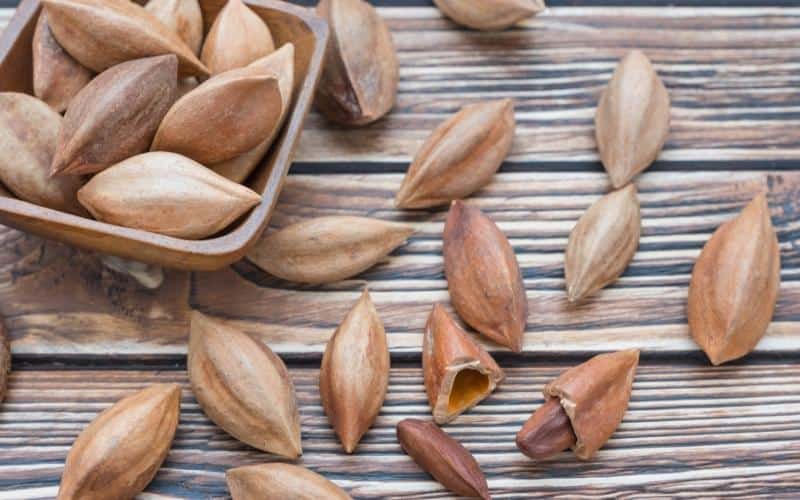
There’s a good chance that you’ve never heard of pili nuts. After all, these nuts are specific to the Philippines! That said, if you’re a fan of nutrient-rich nuts, you’ll want to add pili nuts to your shopping list.
These nuts grow in mineral-rich volcanic soil, imbuing them with various nutrients, including magnesium and phosphorus. They’re also full of monosaturated fats, which might help lower cholesterol levels.
But one of the biggest draws of these peanut-like nuts is their flavor. Pili nuts are unique thanks to their butter-like richness, making them a perfect addition to cookies, cakes, as well as ideal standalone snacks. However, you’ll likely spend about $34 for a single pound of these tasty nuts.
Why It’s Expensive
Unlike common nuts like peanuts and almonds, pili nuts primarily originate from the Philippines. More precisely, pili nuts are grown within the peninsulas of the Philippines, and they don’t thrive in many other places.
These nuts are more expensive than domestic nuts due to their specific environmental needs, desirable flavors, and associated shipping costs. But if you’re planning to visit the Philippines, you might be able to score a great deal on some pili nuts!
1. Mediterranean Pine Nuts
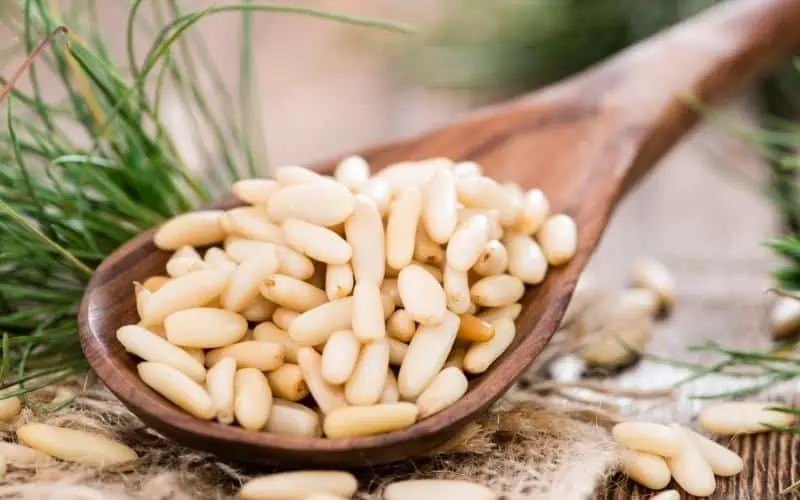
Though pinyon pine trees grow throughout the semiarid regions of North America, the priciest pine nuts hail from countries within the Mediterranean region. The most expensive of these nuts come from Italy, Spain, and Portugal.
Mediterranean pine nuts are a golden color, and they’re unbelievably smooth, having an almost silk-like texture. They’re harvested from mature pine cones, which is a labor-intensive process. Generally, these nuts are often priced at $45 per pound.
Pine nuts are a primary ingredient for many dishes, including pesto sauce, hummus, pignolia loaf, and pine nut cookies. If you’re looking for an elevated and luxurious experience, be sure to snack on a few Mediterranean pine nuts while sipping a glass of the world’s most expensive milk!
Why It’s Expensive
One of the primary reasons these nuts are so costly is that they grow in faraway countries. However, exclusivity is another factor to consider. After all, Mediterranean pine nuts can only be grown in Mediterranian regions!
But cultivation methods are another reason you can expect to spend more than $40 per pound for these nuts. Mediterranean pine nuts are often harvested from wild-growing trees far away from modern sources of human pollution.
As such, they enjoy pristine environments that enrich them with an assortment of nutrients and flavors. Thanks to their complex flavor profile and smooth texture, Mediterranian pine nuts are popular. Unfortunately, this popularity generates a higher level of demand, raising prices.
Try These Expensive Types of Nuts
If you’re looking to treat yourself to the most expensive nut, you’ll want to pick up a bag of Mediterranean pine nuts. But, of course, if you’re allergic to pine nuts, you might want to opt for pili nuts or pistachios instead.
No matter your budget or tastes, there’s a high-quality nut or legume that can suit your needs. Besides, nut health benefits make these snacks a healthier treat than chips, pretzels, or rice cakes!
Are you interested in learning more about the world’s most expensive foods? If so, check out our blog now!

